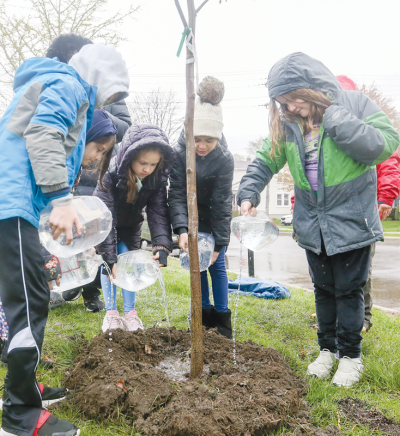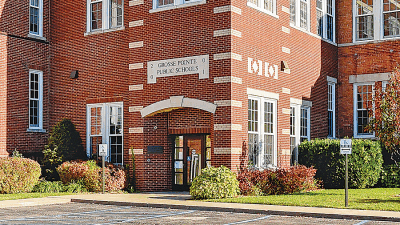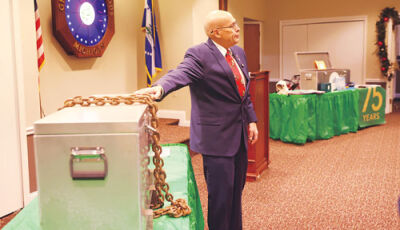
All trees need water, especially newly planted ones like this one that was planted last spring with help from students at Maire Elementary School in Grosse Pointe City.
File photo by Patricia O’Blenes
GROSSE POINTE FARMS — With benefits like providing shade and improving property values, it’s no wonder many homeowners add trees to their property. But there’s a lot more to choosing and maintaining a tree than picking one out based on appearance alone.
Brian Colter, who’s certified by the International Society of Arboriculture and is the urban forester for Grosse Pointe City, Grosse Pointe Farms and Grosse Pointe Park, has been planting and caring for trees for more than three decades, and he shared his expertise during a residential tree selection and maintenance program organized by the Farms Beautification Commission April 23 at Pier Park in the Farms.
Among his tips: Before planting, look up. Colter said homeowners need to consider the size of the tree at maturity.
“Don’t plant a large-growing tree under utility wires,” Colter said.
He said taller trees should be planted at least 35 feet from utility lines.
When mulching around the base of a tree, create a doughnut shape, not a volcano shape, because that’s not healthy for the tree, as it can rot the trunk and prevent water and nutrients from reaching the tree’s crown.
“You don’t want mulch against the trunk of the tree,” Colter said.
Like real estate, one key to a healthy tree is location, location, location.
“They always say the right tree in the right place, and most of us don’t really know that,” said Pat Deck, of Grosse Pointe Park, a longtime member and former chair of her city’s Beautification Commission. “I think that’s pretty critical.”
That means considering the amount of sunlight the tree will get and whether it has room to grow in the spot where it’s planted.
Before planting a tree, residents should call Miss Dig toll-free at 811 so they don’t accidentally hit or sever underground utility lines.
“As important as it is to look up, you also have to consider what’s underground,” Colter said.
Watering trees — especially those that are newly planted — is the most important thing people can do to keep them healthy. Colter said standard lawn irrigation isn’t adequate for trees, as it doesn’t encourage the roots to grow deep underground.
“Right after planting a tree, you want to saturate it,” Colter said.
Climate is a consideration as well. Colter said Michigan is now in the same hardiness zone that the Carolinas were in, in 1994. That means some trees are more prone to pests than they were 30 years ago, because those pests can survive the winter. But, it also means that species like crepe myrtle can also now be planted here, he said.
Pines provide year-round greenery but are also among the tallest trees.
“Pines are fine, but not as street trees,” Colter said. “It’s an obstruction for the line of sight.”
There are three pines native to Michigan: white, jack and red, Colter said. Austrian pine commonly gets fungus, and he also cautions against Scotch pine — also known as Scots pine — as it’s susceptible to pine wilt and other disease and pest problems.
Some of the small trees Colter recommends include tree lilac, hornbeam, redbud and staghorn sumac.
Colter said oaks are good shade trees, and the Michigan State University Extension lists white, red and bur oaks as native to Michigan. However, because of the concern over oak wilt — which hasn’t yet been found in metro Detroit but is common in northern parts of the state — Colter warns against planting too many oaks, in case it spreads here. People should refrain from bringing firewood home from northern Michigan as well.
“Buy your firewood locally … because you could (otherwise) be bringing in (the oak wilt) tree fungus that’s underneath the bark,” Colter said.
Trees to avoid for reasons including health and pest issues include Callery pear (also known as Bradford pear), tree of heaven, silver maple and black locust.
Trees should only be pruned when dormant and should never be topped, Colter said. Homeowners shouldn’t remove more than 25% of the foliage during the growing season and should avoid using wound paint. Colter said the branch collar should always be left intact.
When in doubt about pruning, Colter said people should consult with a certified arborist.
As to when to plant a tree, Colter said fall and spring are equally good times.
Although Colter gave his presentation in the Pointes, Grosse Pointe Farms Assistant City Manager Derrick Kozicki said his advice was applicable regionally.
“These issues are being dealt with in every community in southeast Michigan,” Kozicki said of pests, diseases and other concerns that impact urban forestry.
To find an ISA-certified arborist in Michigan, visit asm-isa.org.
 Publication select ▼
Publication select ▼




















